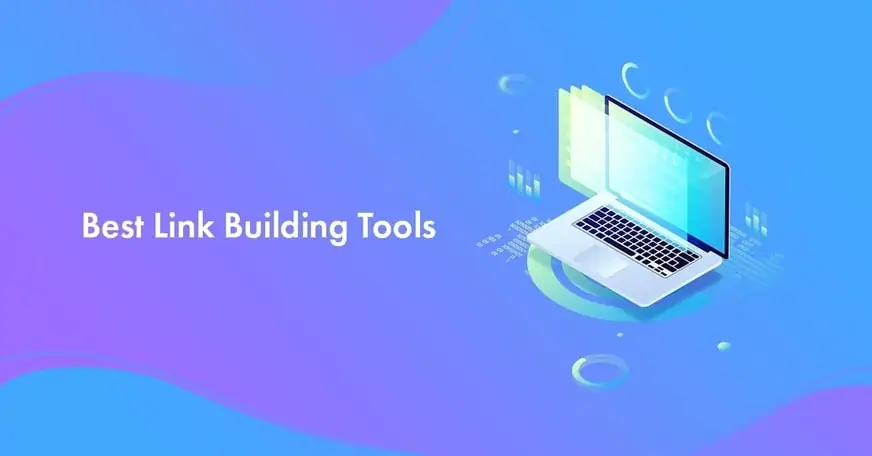Topic clusters help you organize your content more effectively and improve overall topical authority.
Instead of writing random blog posts, you focus on creating one pillar page and linking to other relevant posts around it. That way, you build authority on one topic, improve user experience, and help search engines better understand what your website is all about.
In this post, we’ll discuss some of the real-life topic cluster examples used by popular brands, including Airbnb, Shopify, Statista, etc.
Whether you’re completely new to the SEO game or planning to improve your existing SEO strategy, these examples will help you build an SEO-friendly website.
Table of Contents
What Are Topic Clusters?
Topic clusters (also known as content clusters) group related topics together on a website.
They help build topical authority by grouping similar topics together.
Even small websites can use topic clusters to improve their website’s authority. By creating a main pillar post (such as “Complete Guide to SEO”) and linking related articles (like “Keyword Research Tips” or “On-Page SEO Basics”) back to it, they can demonstrate their expertise.
Here’s a detailed free guide on how to do keyword clustering for beginners. Let’s now explore some examples of topic clusters in research.
The Best Topic Cluster Examples for 2026
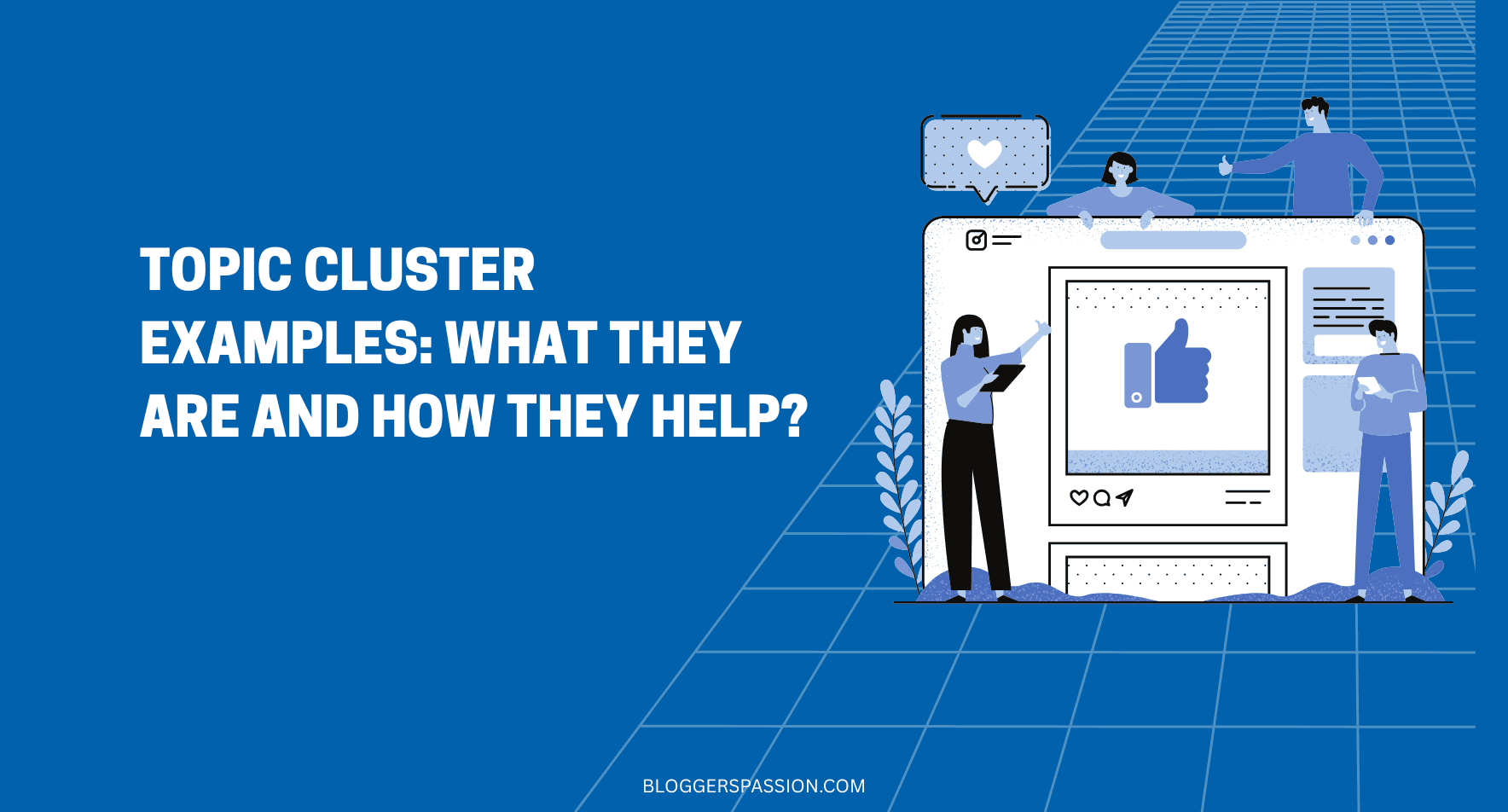
If you want to better understand what topic clusters are, check out these real-life examples of top websites, including Etsy, Salesforce, Shopify, etc.
Seasonal & Trending Clusters
Seasonal and trending topic clusters are those clusters that get high search demand during a particular season or trend.
1. Etsy: Holiday gift ideas
Etsy builds seasonal topic clusters around holidays like Christmas, Black Friday, Valentine’s Day, Halloween, etc.
Its main page, “Gifts,” connects to subtopics such as Birthday Gifts, Anniversary Gifts, Christmas Gifts, Father’s Day Gifts, Mother’s Day Gifts, etc.

These specific clusters often generate massive seasonal traffic from search engines. They also help Etsy rank for trend-based keywords (such as Christmas gift ideas) during peak shopping periods.
By regularly adding new gift guides and updating the existing topic clusters each year with the latest products, Etsy stays relevant and attracts more visitors from search engines. This content strategy also helps Etsy attract a new audience who will find highly relevant products each season.
2. Airbnb: Summer travel guides
Airbnb often uses trending clusters that are focused on specific travel seasons, such as summer.
For example, their pillar page on “What’s Trending for Summer on Airbnb” lists popular destinations like Puerto Rico’s secluded areas, bioluminescent waters, and off-the-grid mountain escapes.
Airbnb then links to specific travel types, such as solo travel, beach spots, family-friendly beach towns, romantic getaways for couples, etc.
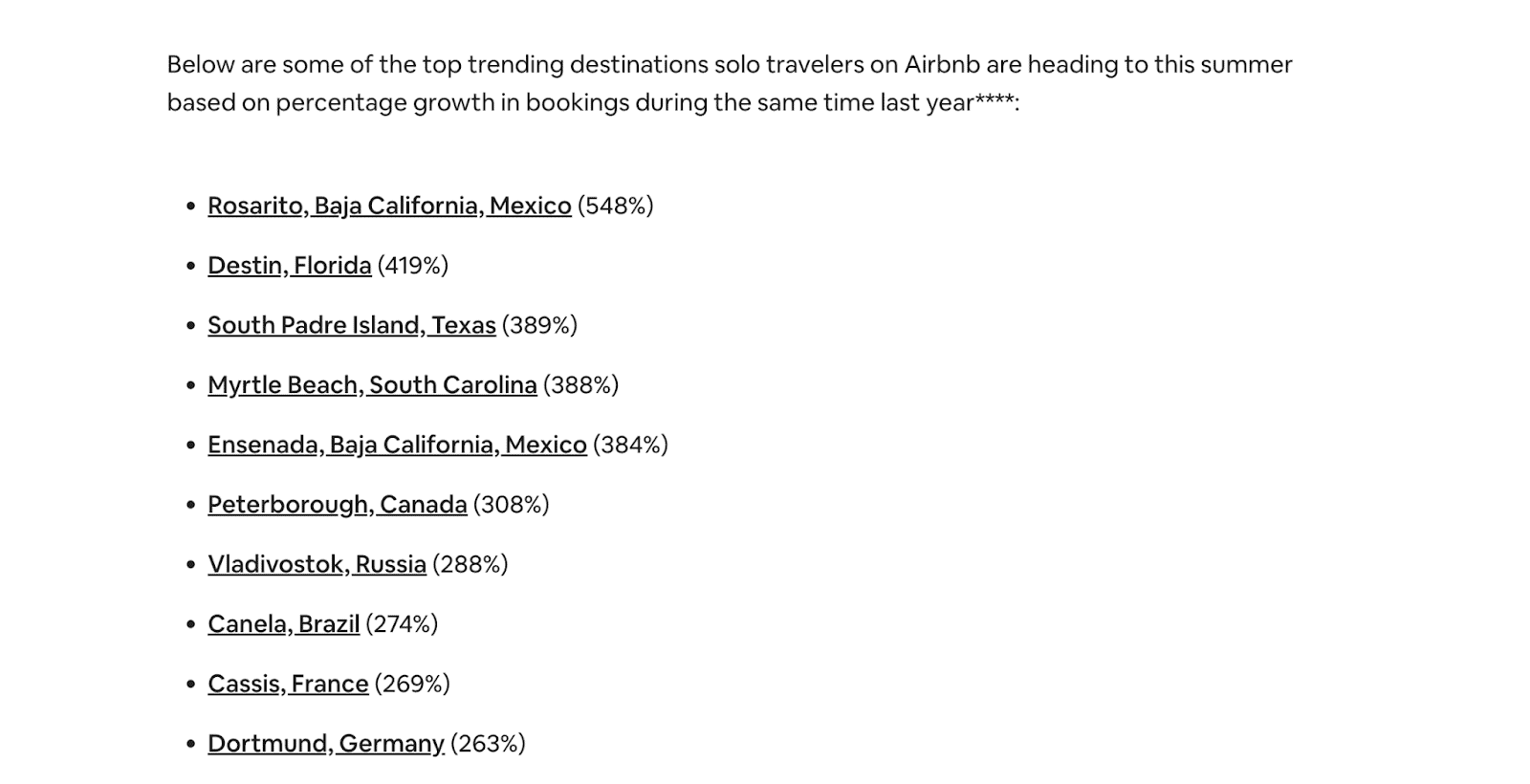
These trending clusters help Airbnb attract seasonal searches and travelers during peak holiday seasons.
By updating these trending clusters with new data and destinations, Airbnb constantly generates more search traffic, leads, and sales to its platform worldwide. It also helps Airbnb users discover new and unique destinations all around the globe.
Verticalized Clusters
Verticalized clusters target niche topics, focusing on a specific audience.
3. Shopify: E-commerce guides
Shopify often uses verticalized clusters to target a niche audience of online store owners specifically.
For example, one of its main pillar pages on “What is eCommerce Guide” links to smaller, detailed articles, including;
- How to create an ecommerce website
- Various eCommerce apps
- What are digital products
- Best ecommerce platforms and more
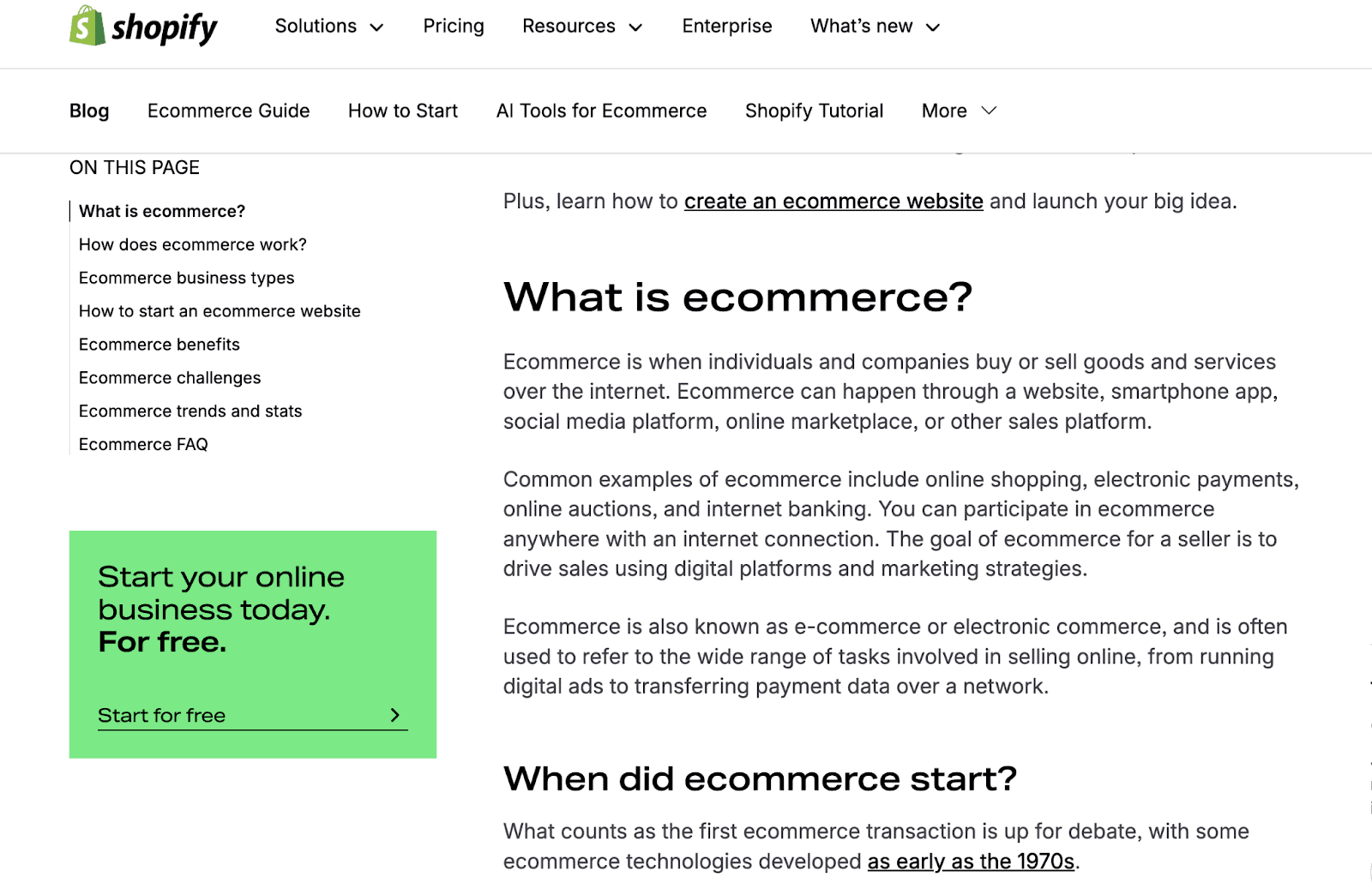
This specific verticalized cluster approach helps Shopify provide comprehensive, niche-specific content that keeps store owners engaged. It also helps link related articles, improve overall navigation, and ultimately build topical authority.
By covering in-depth verticalized clusters like emerging eCommerce trends, AI tools for online stores, automation in marketing, etc, Shopify always keeps its content fresh and highly relevant.
Not only does this approach help them with more search traffic, but it also builds trust among their users.
When it comes to creating topic clusters, finding the right keywords is crucial. If you’re a beginner, here’s a free guide on doing keyword research like a pro. It covers all the essential tips and basics you need to find high-traffic keywords for your website.
4. Salesforce: CRM and Sales Automation
Salesforce uses verticalized clusters to focus on CRM and sales automation. These clusters often help Salesforce target a specific set of audiences who are looking for marketing automation.
For example, its main pillar page on “What Is CRM (Customer Relationship Management)?” links to detailed sub-topics, including;
- Benefits of using CRM software
- Marketing emails
- Sales automation tools
- Lead management best practices
- How CRM improves customer experience
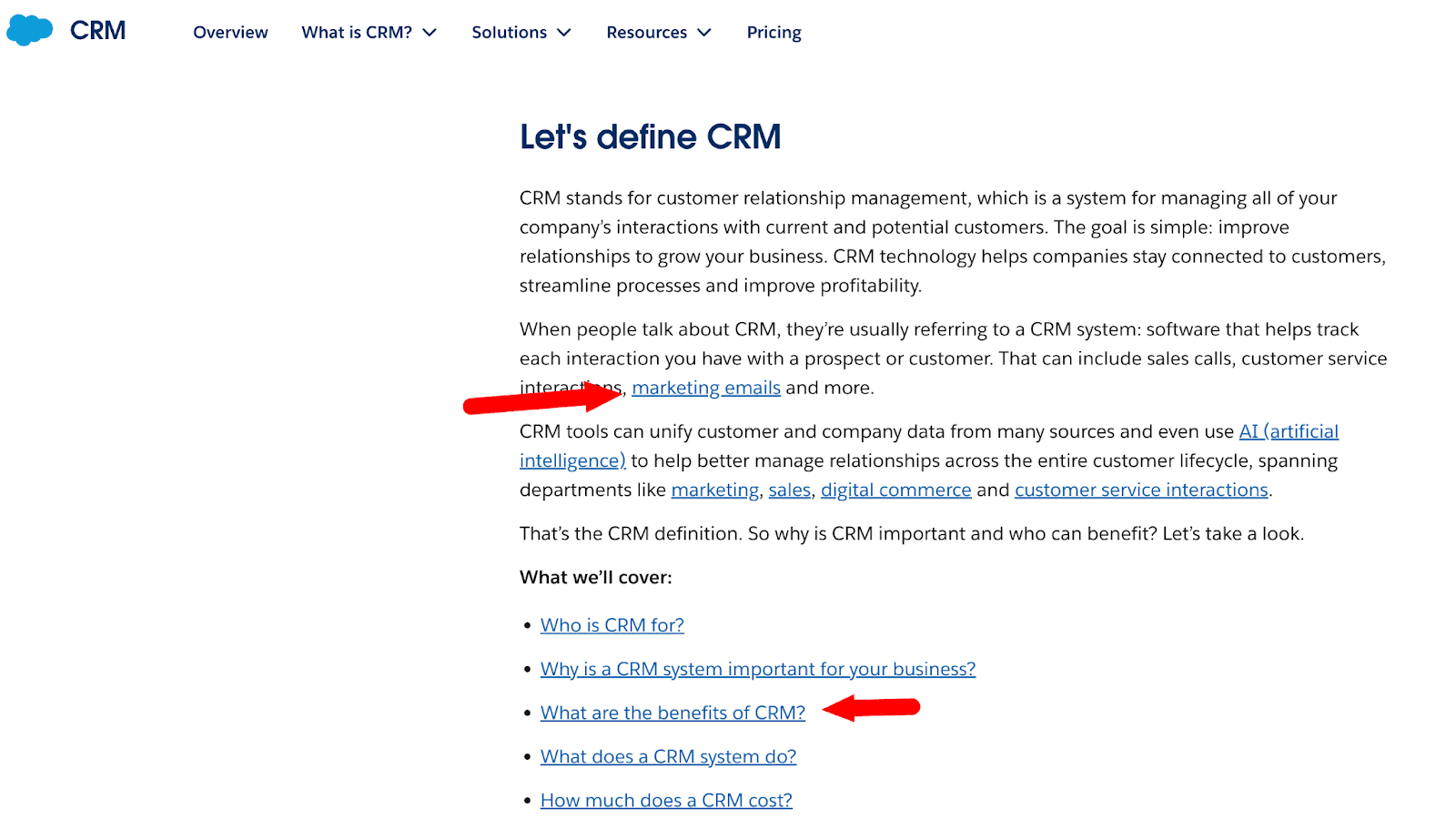
These vertical clusters also help Salesforce build topical authority, improve overall internal linking, and help users find exactly what they want in one place.
By creating detailed clusters and guides on CRM and automation, Salesforce attracts a highly targeted audience who are interested in its products. This approach ultimately helps them with more sales and how to use their CRM products more effectively.
Databases
Database clusters primarily focus on statistics or data-driven content.
5. Statista: Data and stats related clusters
Statista is known for providing a massive library of over 22,500 sources on over 60000 topics.
It often uses database clusters to organize vast amounts of statistical data across industries.
Each main topic, such as “Internet,” serves as a hub linking to detailed statistics, including sub-topics like digital population, social media usage, average daily time spent on social media, and app trends.
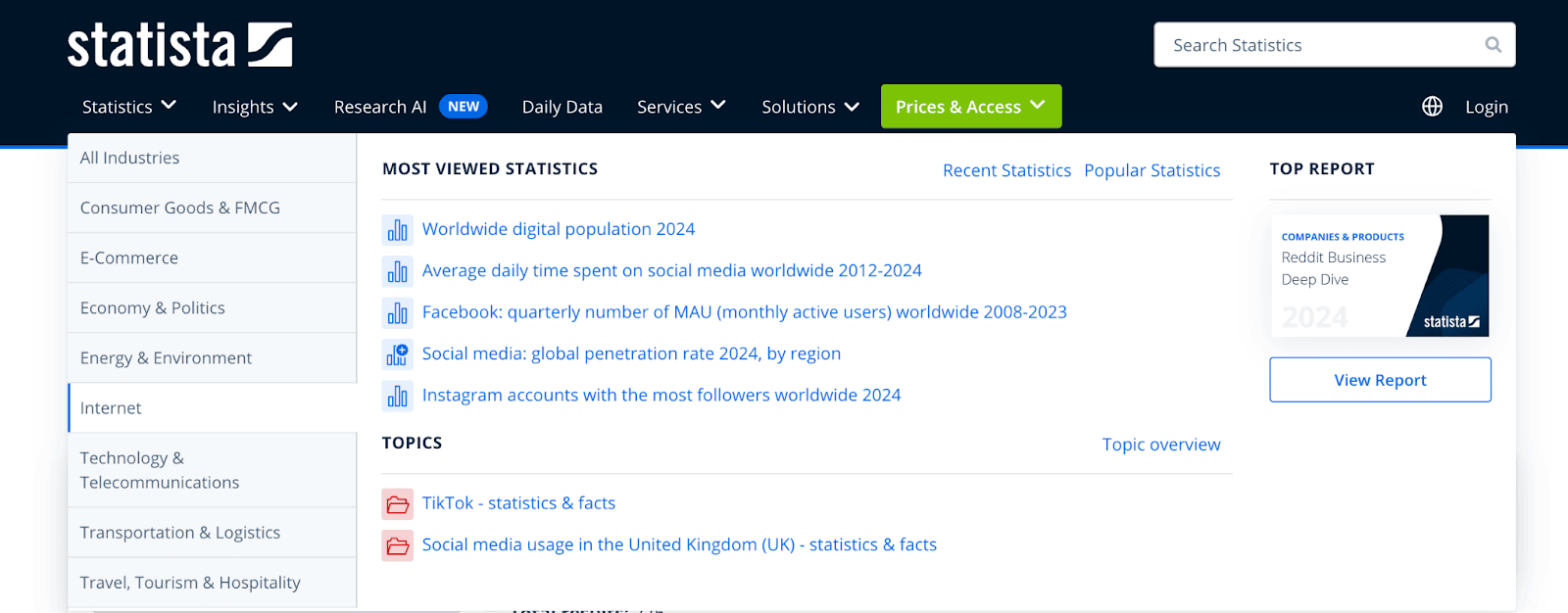
Each of those clusters helps its users quickly find relevant and highly interconnected information for research and in-depth analysis.
These database clusters also serve their primary target audience, who are marketers and researchers who are looking for verified data and stats in one place. It helps them with better site authority and visibility for data-driven searches.
6. Crunchbase: Company & startup database
Crunchbase has an extensive database collection of thousands of startups and companies worldwide. It has created many database clusters for companies, startups, and investors.
Each company or startup profile acts as a hub linking to related data like funding rounds, founders, acquisitions, and industry trends.
For example, on the Crunchbase page on X, users can explore a structured database-style cluster covering sections like Overview, Financials, People, News, and Technology.
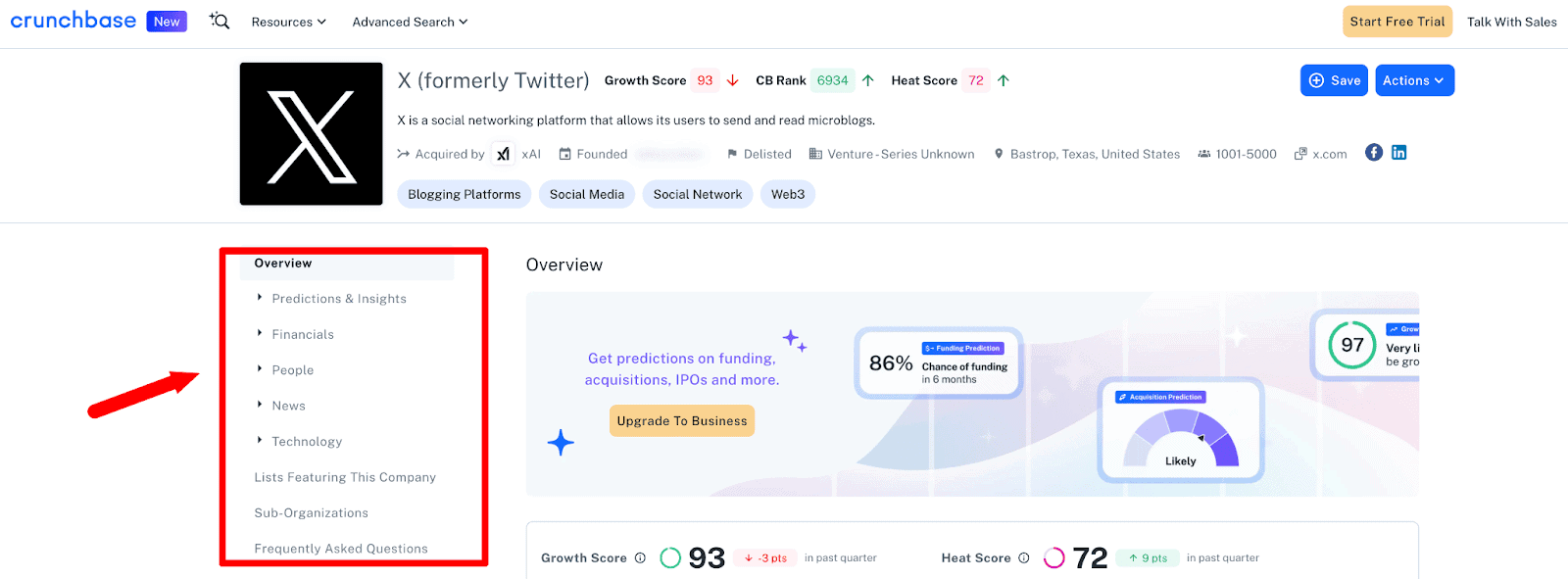
Each of those sections provides quick information, allowing anyone to analyze the company’s growth, funding history, and organizational details at one central hub.
Crunchbase’s in-depth resources on all the major startups help it build strong topical authority in the investment and startup fields. By creating a detailed overview of each company, including its funding rounds, investor profiles, and emerging startups, Crunchbase becomes the go-to source.
Subject Guides
Subject guide clusters focus on in-depth guides and tutorials related to a specific topic.
7. BloggersPassion: SEO and Affiliate Marketing
BloggersPassion features over 500 articles on a wide range of topics. All the articles are organized into various categories, including AI, SEO, and affiliate marketing.
For example, in the SEO category, you’ll find hundreds of detailed tutorials on search engine optimization, including keyword strategies, content optimization, tools, and more.
On BloggersPassion, the SEO Tutorial for Beginners serves as a pillar page that connects to multiple in-depth subtopics, including keyword research, on-page and off-page SEO, link building, and technical optimization.
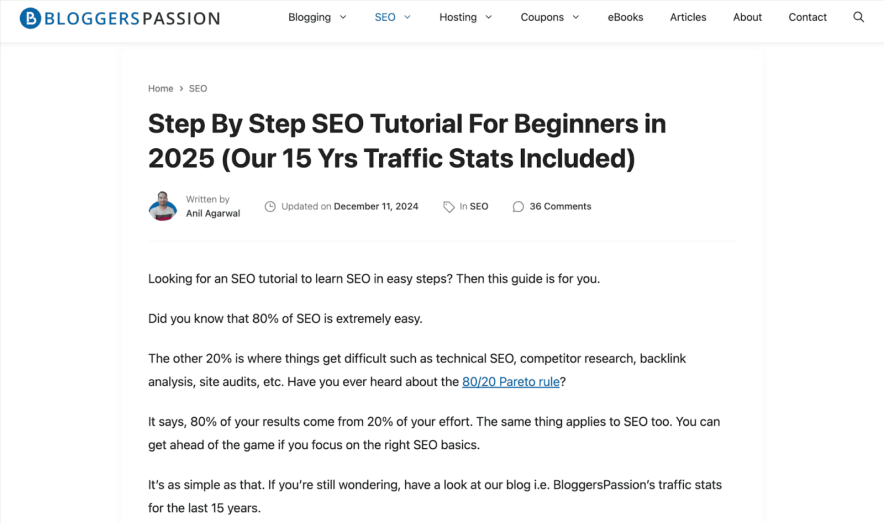
The pillar page includes content strategy, link building tips, and keyword research advice, making it a valuable resource and contributing to BloggerPassion’s topical authority.
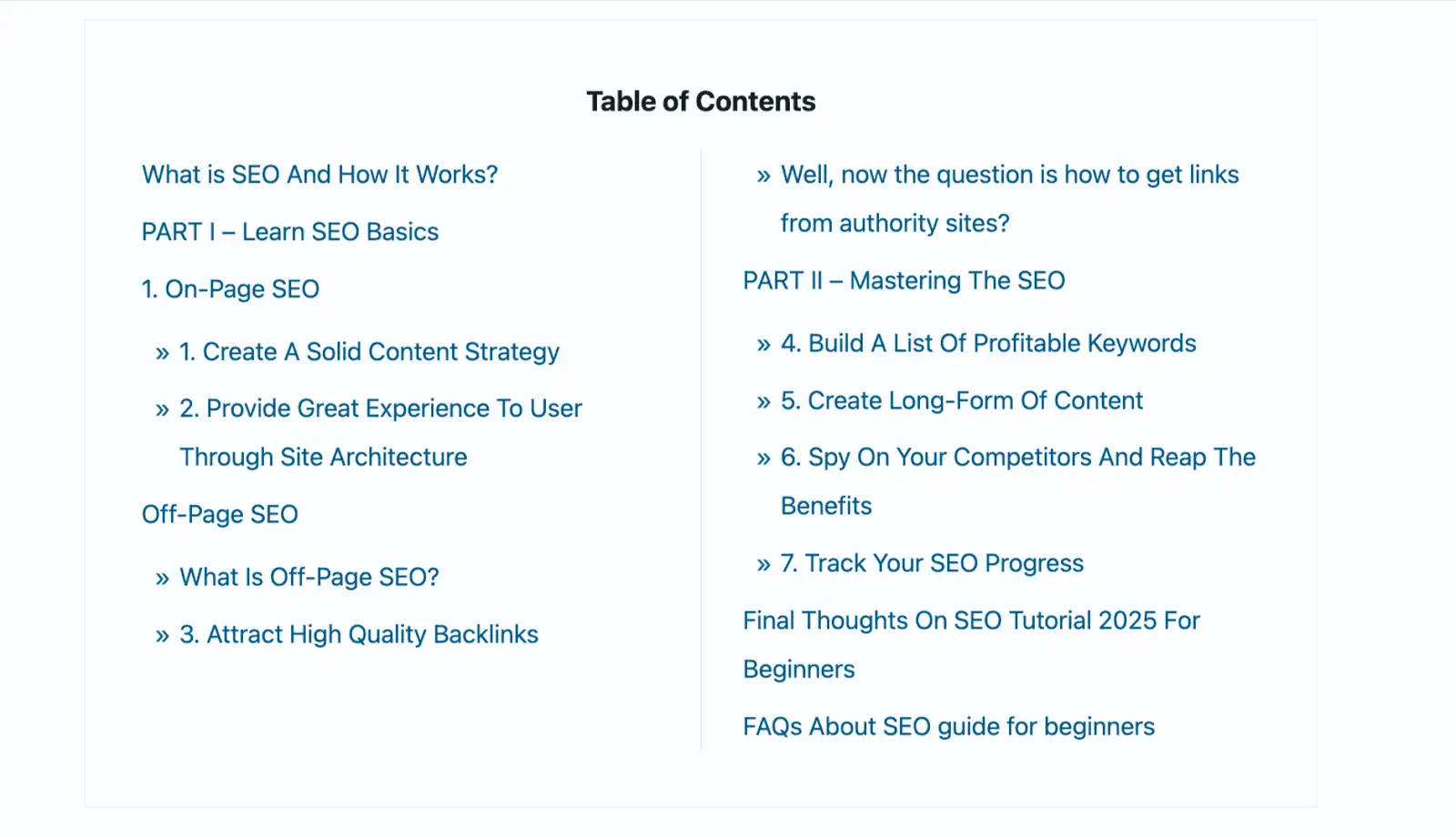
Also, each of those supporting articles links to the main tutorial, forming a topic cluster. These highly relevant subject guides help BloggersPassion readers find one related topic to another.
By updating these guides frequently and targeting new long-tail keywords, BloggersPassion attracts more search visitors and becomes the go-to resource for SEO and affiliate marketing.
8. Ahrefs: Beginners SEO
Ahrefs has a subject guide cluster on “The Beginner’s Guide to SEO” which connects to multiple relevant sub-topics like;
- “How Search Engines Work” — basics of crawling and indexing
- “SEO Basics” — four key parts of SEO
- “Keyword Research” — what target audiences search for
- “On-Page SEO” — optimizing individual pages
- “Link Building” — getting authoritative links
- “Technical SEO” — site structure, speed, and indexing
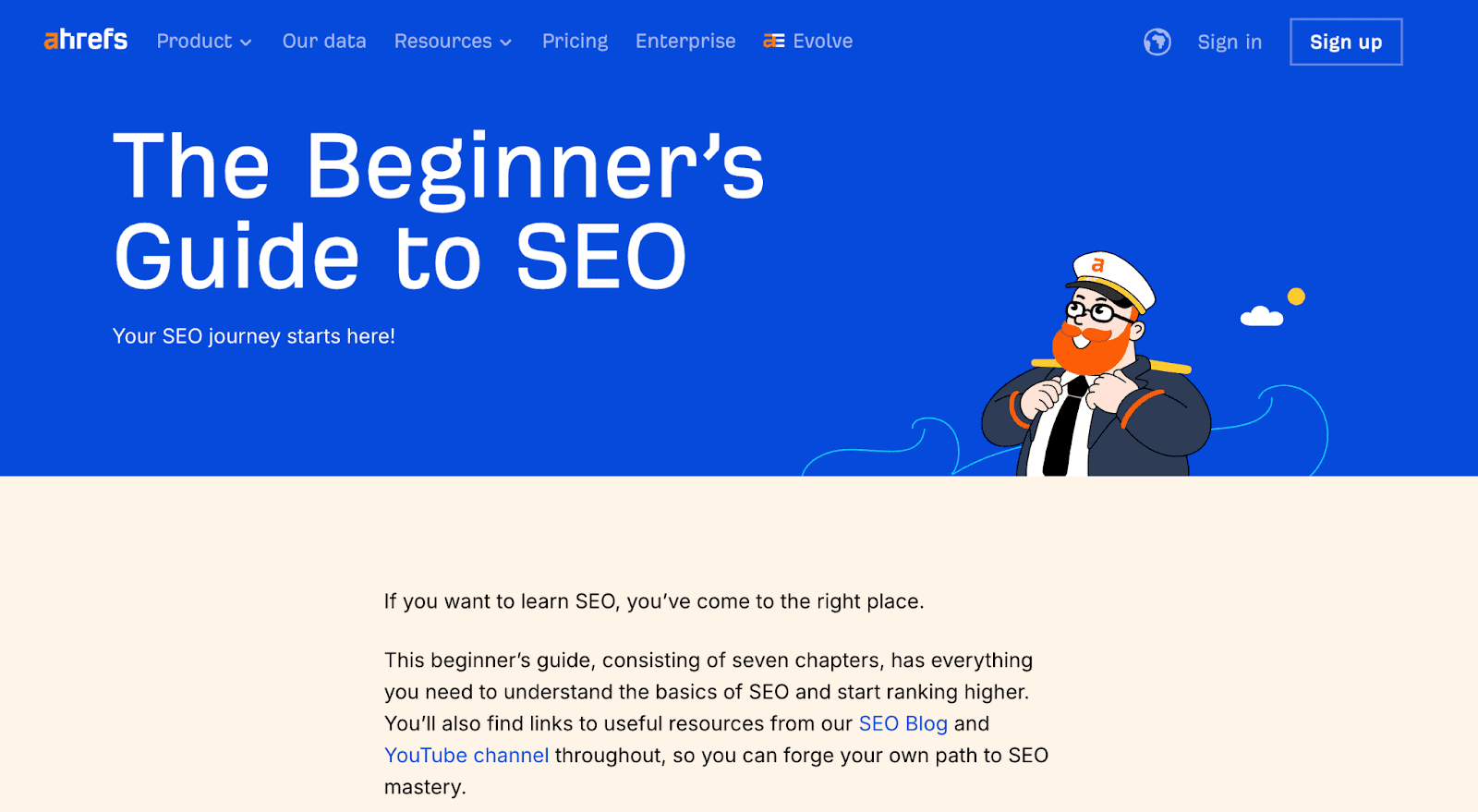
Subject guide clusters like these help your audience to everything from basic concepts to actionable strategies in one place.
The best thing about subject guides is that they group related articles on one main topic, making it easier for readers to explore and learn step by step. Also, these clusters help search engines understand the content structure and improve the overall website experience.
You need to find trending topics for your blog if you’re focused on creating topic clusters around subject guides.
Content Libraries
Content Library Clusters focus on curating all related resources around a core topic. Content libraries can include anything from blog posts to in-depth guides to infographics, videos, tutorials, and more.
9. BBC News: COVID-19 coverage
The BBC provided extensive coverage during the COVID-19 pandemic.
The COVID pandemic was the central topic, around which the BBC covered many sub-topics, including new virus variants, vaccinations, government measures, social distancing, and global outbreaks.

Essentially, the BBC created an exclusive Content Library Cluster to help organize all related content around a central topic (which is COVID).
Content libraries work particularly well for news organization sites that cover a wide range of topics, as they make it easier for readers to find news articles or stories by category.
10. Forbes: Finance resources
Forbes built a comprehensive Content Library Cluster around “Money”.
The core topic “Money” is connected to sub-topics like;
- Banking and insurance
- Fintech
- Investing
- Markets
- Personal finance
- Retirement, etc
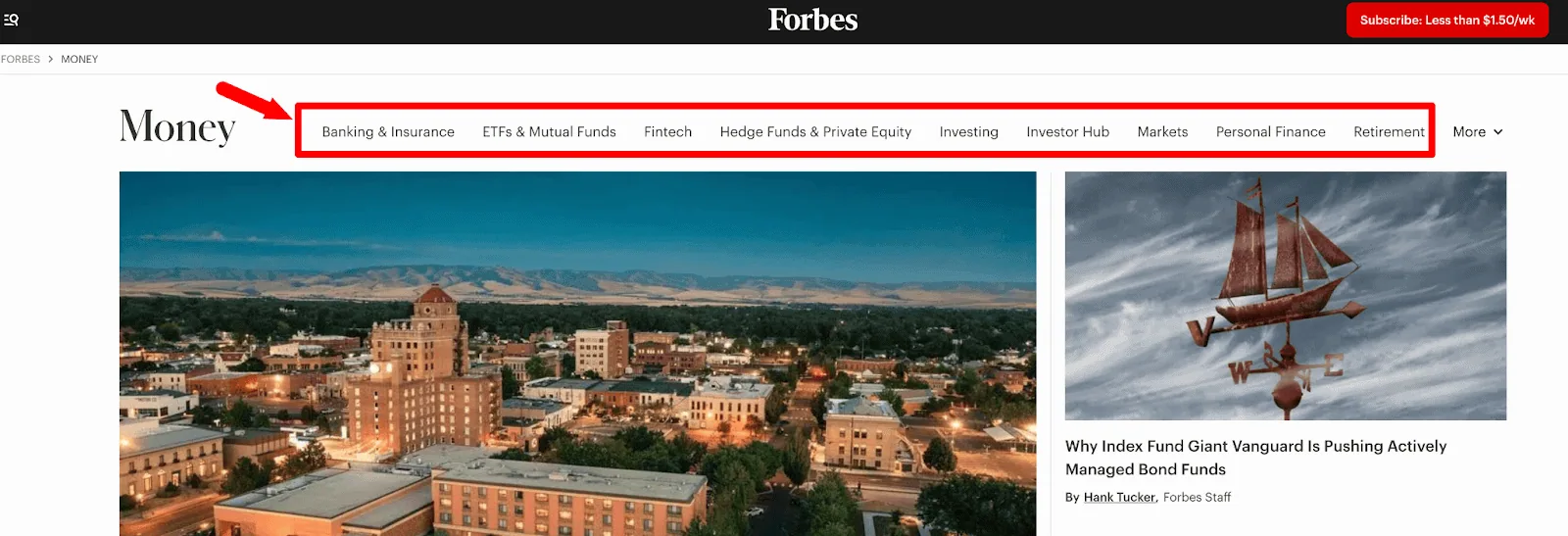
In each of those sub-topics, like Retirement, you’ll find many more resources and educational guides.
In a content library, you organize both new and evergreen posts by grouping them under similar topics. For example, if your site covers SEO, you could have one content library for keyword research, another for link building, and one more for content optimization.
These organized topic clusters help Forbes readers easily explore all finance-related insights in one place. They also help Forbes’ audience quickly find information on a specific subject, improving its user experience and overall topical authority.
Hub and Spoke Model
The hub and spoke model consists of one central hub that connects to all spokes. These often contain a relevant set of interlinked pages on a single topic.
11. HubSpot: Ultimate Guide to Instagram Marketing
HubSpot used the hub and spoke model to organize its “Instagram Marketing Ultimate Guide”.
Here, the main hub post (i.e, pillar page) acts as a primary resource, linking to several spoke articles covering topics like Instagram ads, marketing strategy, types of Instagram posts, and engagement tips.
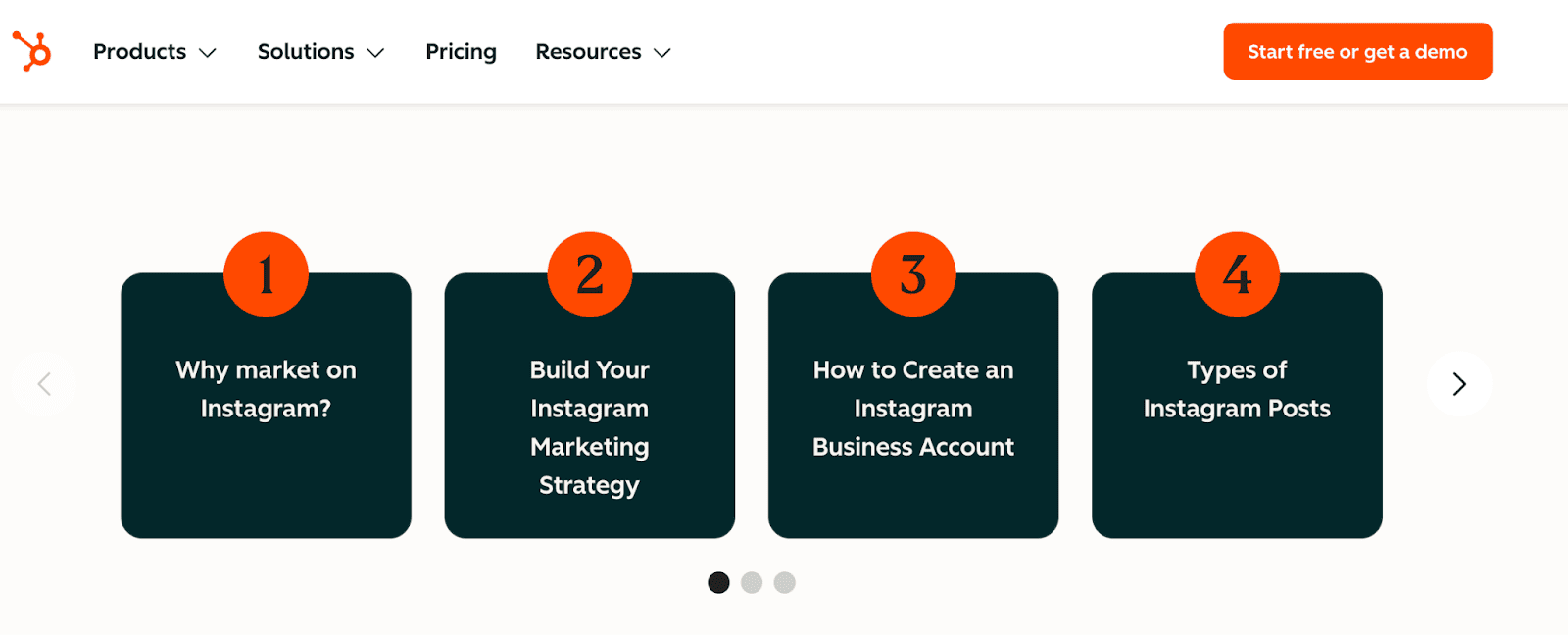
The spokes, along with the primary hub, are all connected to improve the overall topical authority on one subject, i.e, Instagram guide.
Basically, the Hub page focuses on broad keywords (example: “Content Marketing”), whereas the spoke pages target specific, long-tail keywords related to the main topic (example: “Content marketing tools for beginners”).
12. Podia: Online course creation guides
Podia also uses the Hub and Spoke Model for most of its course creation guides. One specific example is “How to create and launch a profitable online course”.
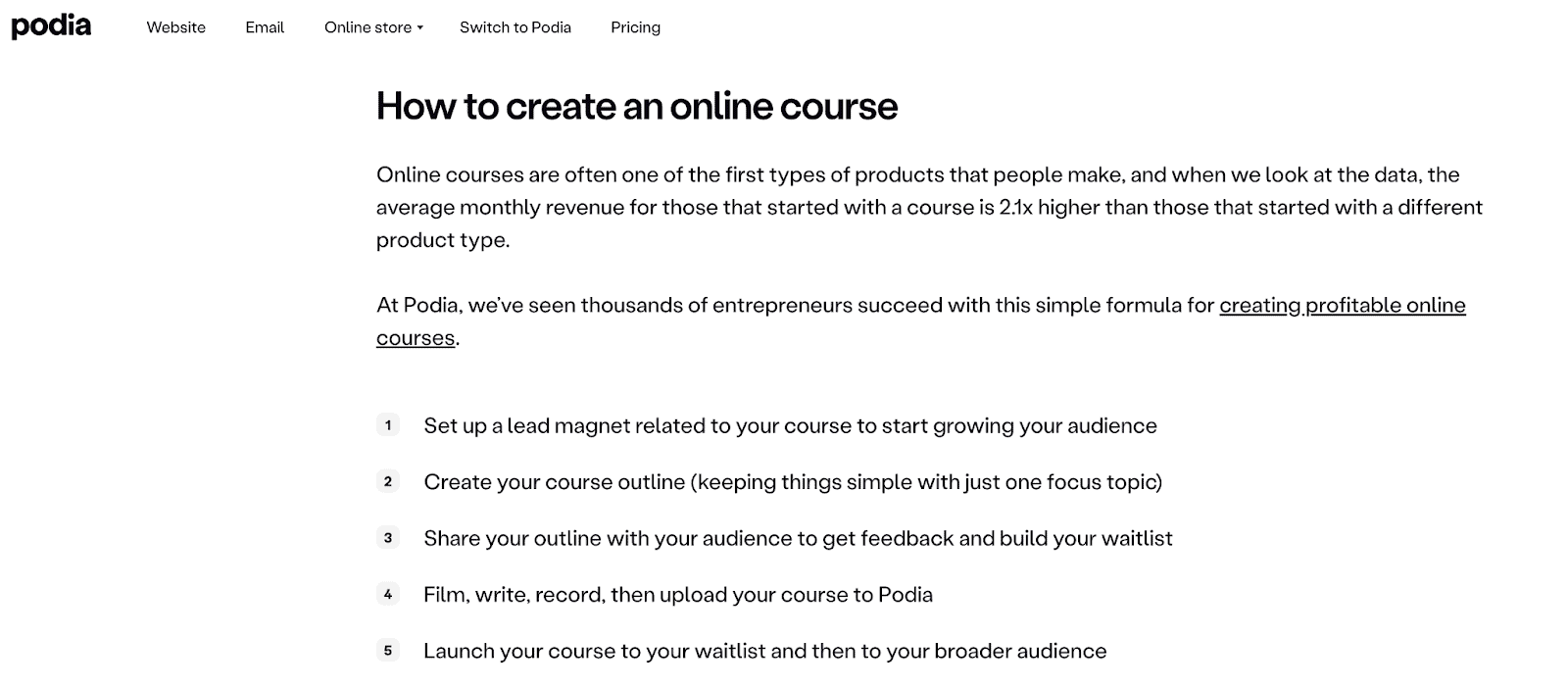
The central hub focused on how to create and sell online courses, linking to spoke articles about creating free lead magnets, writing blog posts, planning courses, recording videos, developing pricing strategies, and implementing marketing tactics. This approach makes it a one-stop guide for beginners.
This Hub and Spoke setup (used by Podia) helps organize its content clearly, improve overall internal linking, and boost search rankings.
Remember, deep internal linking to both the hub and the spoke page is essential to boost topical authority, crawling, and improving content relevance.
How Topic Clusters Help In SEO in 2026?
Topic clusters are essential for building topical authority and improving your search rankings.
Here are some of the key benefits of creating topic clusters in 2026.
When you build topic clusters on one particular topic, you’re telling Google that you’re an expert in that subject. It is also helpful for improving EEAT signals on your website. It ultimately helps with building trust and search engines ranking your website higher.
For example, if you publish multiple high-quality guides about “AI in SEO”, Google will recognize your site as an authority on that topic, which helps build topical authority.
Better search rankings
Topic clusters often involve creating a pillar page with detailed information to cover a topic comprehensively, and then linking related subtopics or articles to it. It helps with better keyword optimization and makes search engines better understand your content.
Also, proper interlinking helps Google easily find and index your pages, ultimately improving your rankings.
Increased user experience
Topic clusters enhance the user experience by allowing users to easily find highly relevant content in one place through internal links.
They also help boost user engagement metrics, as;
- People will spend more time reading a pillar post and exploring related content.
- Increased page views
- Reduced bounce rates and better dwell time
- Improved session duration and more
Conclusion on topic cluster usage
SEO is evolving faster than ever with the introduction of AI search systems, such as AIO and GEO. If you want to improve your search rankings, you need topical authority.
That’s why all website owners need to use topic clusters by linking related articles to a central pillar page to show expertise on a specific topic.
So, what are your thoughts on topic clusters? Do you optimize and organize your content for topical authority and better user experience? Have any questions? Let us know in the comments.
FAQs on Topic Clusters in SEO
Here are some frequently asked questions about topic clusters.
A topic cluster is a group of closely related articles linked to one main “pillar” article that covers the core topic in detail. They’re thematically interlinked to one another.
The silos primarily help with website structure or navigation, whereas topic clusters involve grouping related topics to build authority.
A pillar page is an in-depth guide or tutorial that covers a specific topic in detail, linking to more detailed subtopics.
Topic clusters primarily help build and improve your website’s authority on a particular topic. They can also enhance the user experience, improve content structure, and improve overall interlinking.
There’s no rule of thumb on how many articles a topic cluster should contain. Typically, a topic cluster consists of one main pillar page and 5–10 related subtopic pages.
![How to Find Trending Topics In 2026 [11 Top Tools Listed]](https://bloggerspassion.com/wp-content/uploads/2019/12/find-topics-for-niche-blog.webp)

